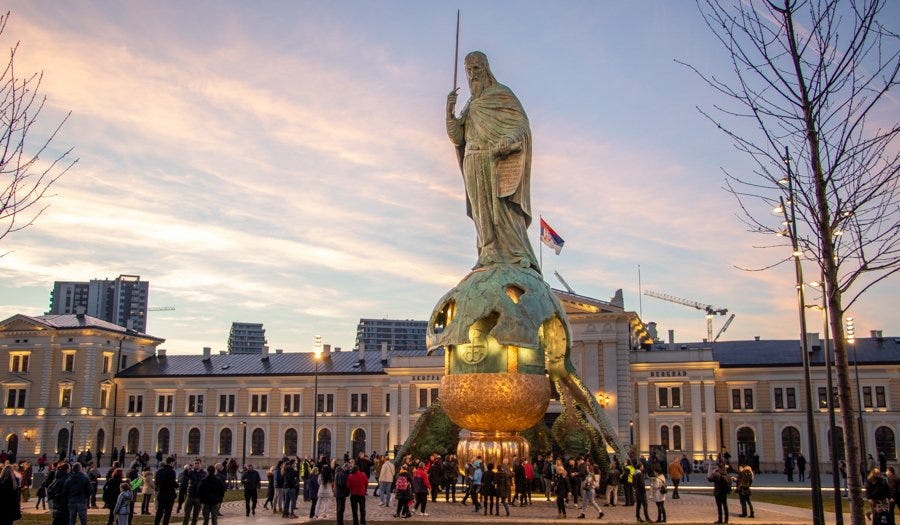The Dual Faces of Serbian Nationalism: Identity, Power, and Manipulation
Belgrade Beat. (n.d.). Stefan Nemanja Monument [Photograph]. Retrieved from https://belgrade-beat.com/attractions/stefan-nemanja-monument
A monument to a Serbian medieval ruler looms over Belgrade, representing Serbian nationalism. The 9-million-euro monument was significant to Serbian President Aleksandar Vucic. He stated that it was "a matter "of taking care of oneself and one's identity".
The building behind is the former railway station, a relic of 19th-century Serbian architecture. It was sold to developers while the station was moved a couple of miles away. Now it stands abandoned behind the gargantuan statue of Serbian nationalism, an analogy of the government hiding its flaws behind national identity. It's a reflection of the Serbian government, failing to provide adequate services and infringing on democratic freedoms while maintaining support under the cover of nationalism.
Nationalism unites a country, fostering compromise and cooperation in building a better future, particularly in post-conflict communities. Misuse can impede a country's growth, with a deceitful leader using it to obscure the nation's grim reality from the population.
Nationalism is often used to suppress domestic dissent and redirect anger towards the “other”. Populist leaders use nationalism to advance their agendas and avoid accountability, appealing to the common people and anti-elitist. Post-conflict communities are vulnerable to this manipulation, as leaders can exploit nationalistic sentiments. The rise of authoritarian governments in post-conflict communities is often accompanied by populist nationalism and ostracization to gain support.
The Serbian government, led by President Alexander Vucic and Prime Minister Ana Brnabic, is becoming more autocratic. According to the US-based Freedom House reports that the ruling Serbian Progressive Party (SNS) “has eroded political rights and civil liberties, putting pressure on independent media, the political opposition, and civil society organizations”. The report states that the government tear-gassed peaceful protesters discontent with the election results last December. The protesters claimed that thousands of votes had been stolen in favor of the SNS. How did Serbia reach this point?
Restructuring Serbian national identity post-Yugoslav Wars
The Yugoslav wars left Serbia deeply scarred, with a humanitarian disaster claiming thousands of lives. The country suffered severe economic and physical devastation, its infrastructure ravaged by bombing campaigns. The atrocities committed by Serbian forces in Bosnia, notably the Srebrenica massacre in 1995 where over 8,000 Bosnian Muslims were killed, remain haunting reminders of the conflict's brutality. The West’s response, intense economic sanctions against Belgrade and NATO’s two-and-a-half-month bombing campaign, ostracized Serbia from its former Yugoslav neighbors and the West. Serbians were left feeling villainized by the international community for its aggression while grappling with the pain of victimhood from Western sanctions and the bombing campaign.
This creates cognitive dissonance in the nation’s psyche, which is only comprehended through strong nationalism. This creates a surge of nationalism, as Serbian confusion over guilt and pain seeks an outlet. In response to confusion over the Serbian identity, there's a strong impulse to deflect blame onto external forces and rally around a collective identity in defense of national pride. Exemplified through Slobodan Milosevic’s quote, “We are not angels. Nor are we the devils you have made us out to be”. Guided by leaders like Milosevic and Vucic, this nationalism forms a strong base of political power for nation reconstruction and political group entrenchment. This allows authoritarian governments to take over on the promise of quick and decisive action, supported by the country’s national identity.
After the Yugoslav Wars, Serbia grappled with reconstructing its identity. While promoting a unitary vision of a shared Yugoslav nation before the wars, Serbia had to shift to an ethnic identity after Yugoslavia's breakup. This coincided with reconciling the conflicting roles of aggressor and victim. To unite the country, Serbian leaders took an aggressively defensive stance, emphasizing crimes against Serbia while downplaying its own. They portrayed Serbians as victims of aggression. This was the challenge Serbian leaders, as protectors of ethnic Serbs, faced.
This rhetoric was evident before the end of the Yugoslav wars. For example, it was the official reason for Serbia’s invasion of Kosovo. The current President Vucic in 1995, mere days before the Srebrenica massacre said, “for every killed Serb we will kill 100 Muslims”. It intensified after the wars, with visible Serbian casualties that politicians could reference to portray Serbians as victims of aggression.
Manipulating nationalism for political gain
Serbian leaders gave their population what they wanted most – acknowledgement of their suffering and respect. By presenting themselves as the “good guys” and victims of history, they advanced their political agenda. For example, Serbian government consistently reminds the international community about the terrors Serbia experienced at the hands of NATO, such when President Vucic compared the Russian aggression in Ukraine to the NATO’s bombing of Serbia during the 78th Session of the UN General Assembly on 21 September 2023. However, Serbia never officially accepted the ICTY ruling Srebrenica massacre a genocide. Furthermore, the government shifted the focus of July 11th away from being an anniversary of the Srebrenica massacre, instead framing it as the anniversary of an assassination attempt on Vucic's life.
Post-conflict communities are at risk of their national identity being manipulated by politicians to stay in power, divert attention from the government’s flaws, and vilify the opposition. This was the case in Serbia, where leaders used nationalism to silence protesters and hide their misdoings.
Vucic’s government demonizes an anti-Serbian “other” to blame its failures on and present Vucic as Serbia's savior. His populist government positions itself as the champion of the Serbian "common people" against the "elite," enabling Vucic to label anyone, including neighboring countries, the West, opposition parties, as part of the elite to suit his agenda (Hasanbegovic, 2020). Vucic's commitment to the common Serbian highlights opposition as the opposite, which he uses to delegitimize it. For example, Vucic called the 2021 protesters in Belgrade far-right extremists, condemning them for violence, vandalism, and disrespecting social distancing during the Covid-19 pandemic. During the unveiling ceremony of the monument to Stefan Nemanja, Vucic refrained from criticizing similar disregard for social distancing. Lastly, nationalism is used to villainize the opposition and divert attention from the government’s failures, as when Serbia’s Progressive Party steered the latest election campaign from domestic issues, like rising inflation, towards nationalistic issues, such as Serbs in Kosovo.
As Serbia enters a new parliamentary term after the recent elections, it's important to watch how the government uses national identity to back its authoritarian rule. Installing expensive monuments and blaming scapegoats isn't true patriotism. It distracts the population from the true issues preventing the nation’s rebuilding after the 1990s conflict. Upholding nationalism should foster unity and progress. Citizens must hold their leaders accountable. Promoting transparency, accountability, and inclusivity can advance towards a brighter future.
Bibliography
Hasanbegovic, A. (n.d.). (In)Stability over Democracy: National Populism, Media Manipulation and Creeping Authoritarianism in Serbia. Retrieved May 2, 2024, from https://repository.gchumanrights.org/server/api/core/bitstreams/e3a2cbdf-daba-4407-811e-9d640512ce7b/content
In this episode Amaliia discusses the post conflict region of Serbia. She is a student journalist with us on a placement organised with the Department of War Studies, King's College, London. This article was edited using Lex.page.
Thank you for your time. Don’t forget to share A4R 🎨 Media Hub. Every share helps.
















